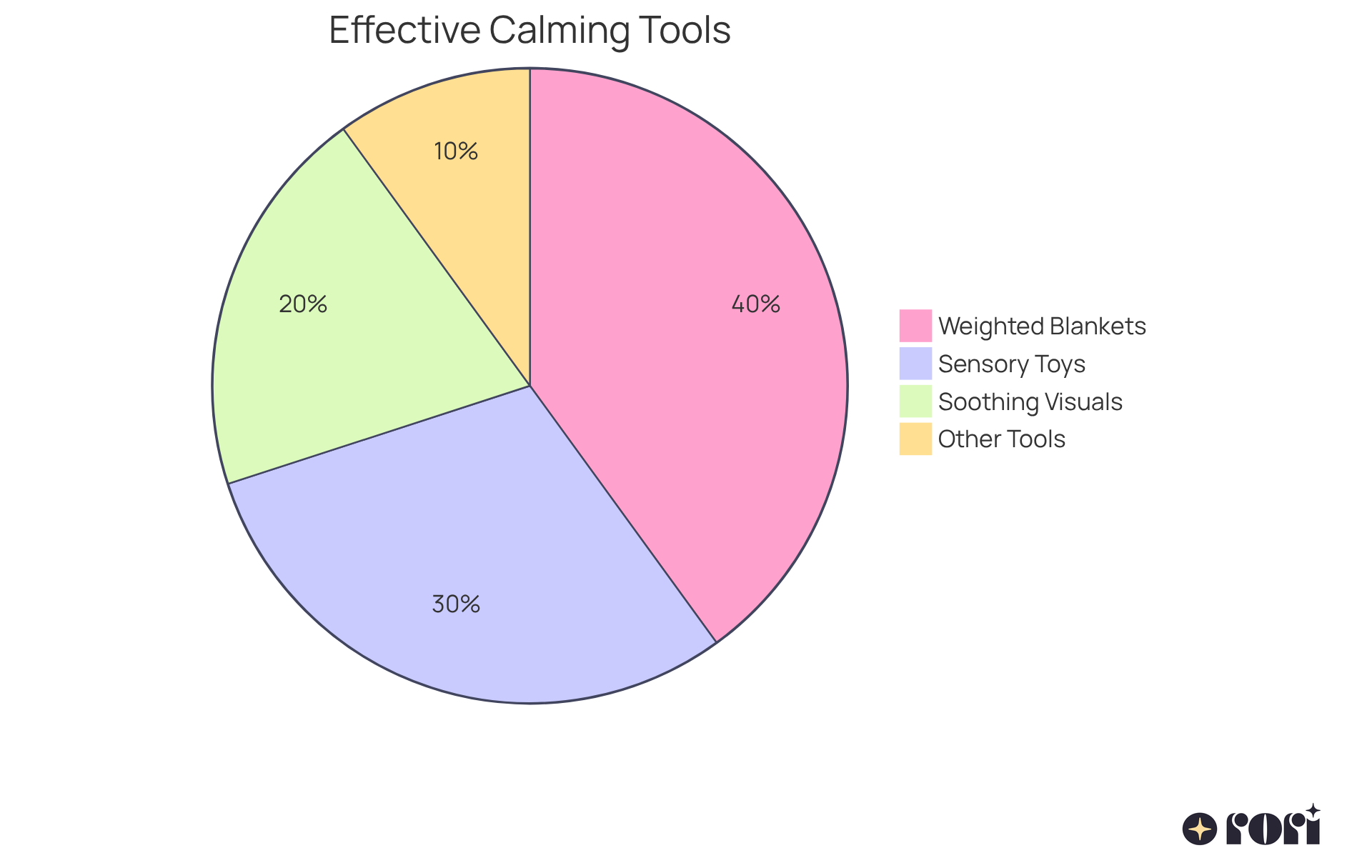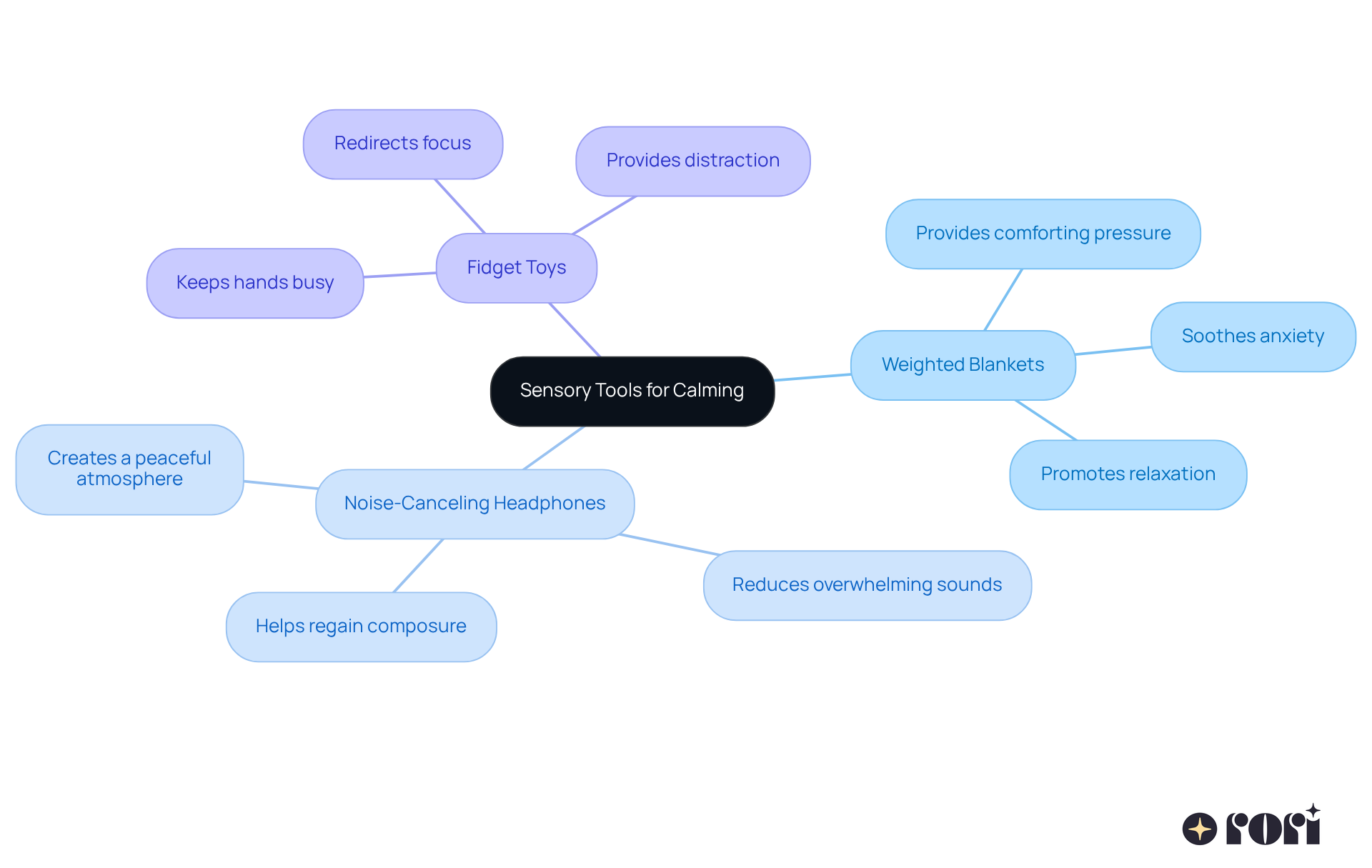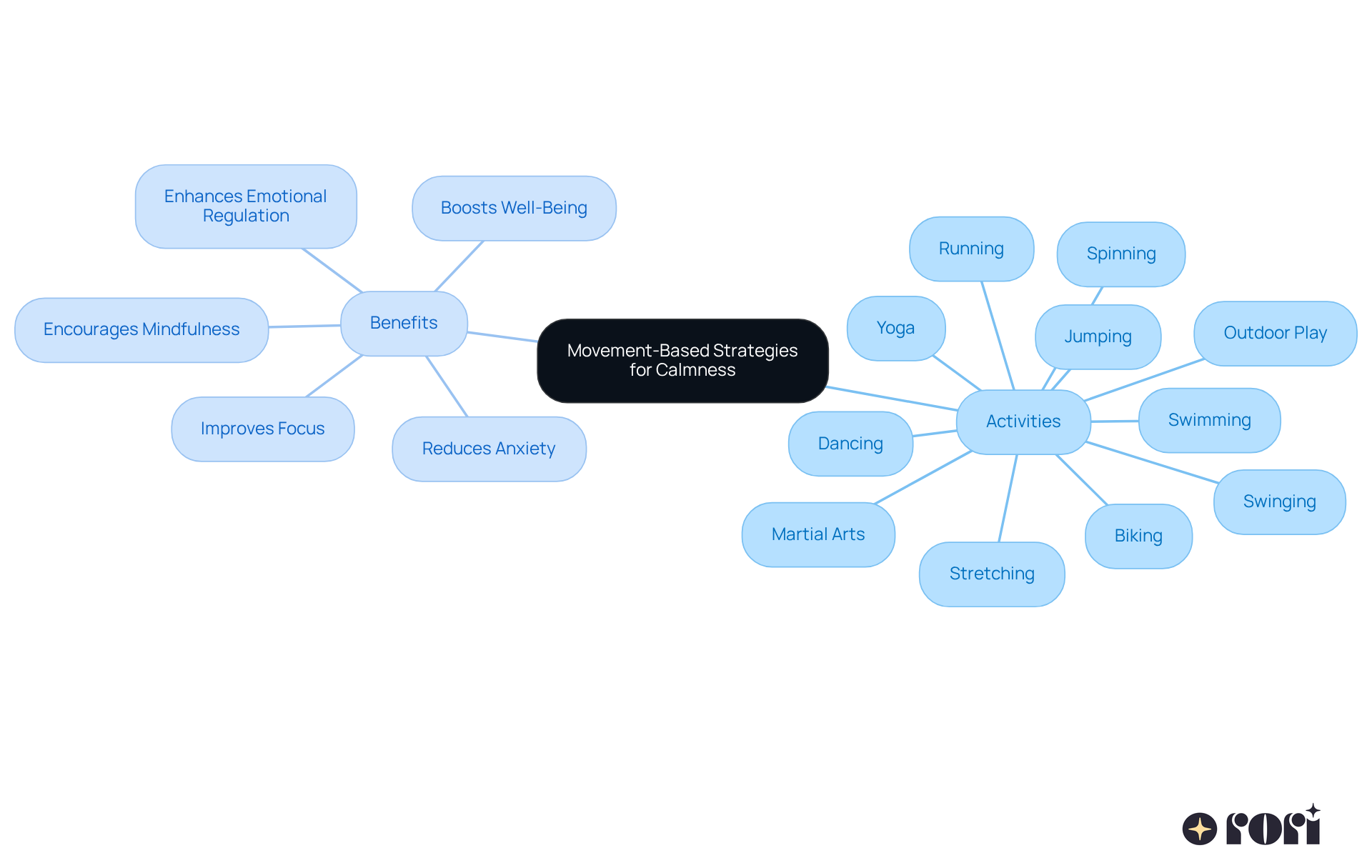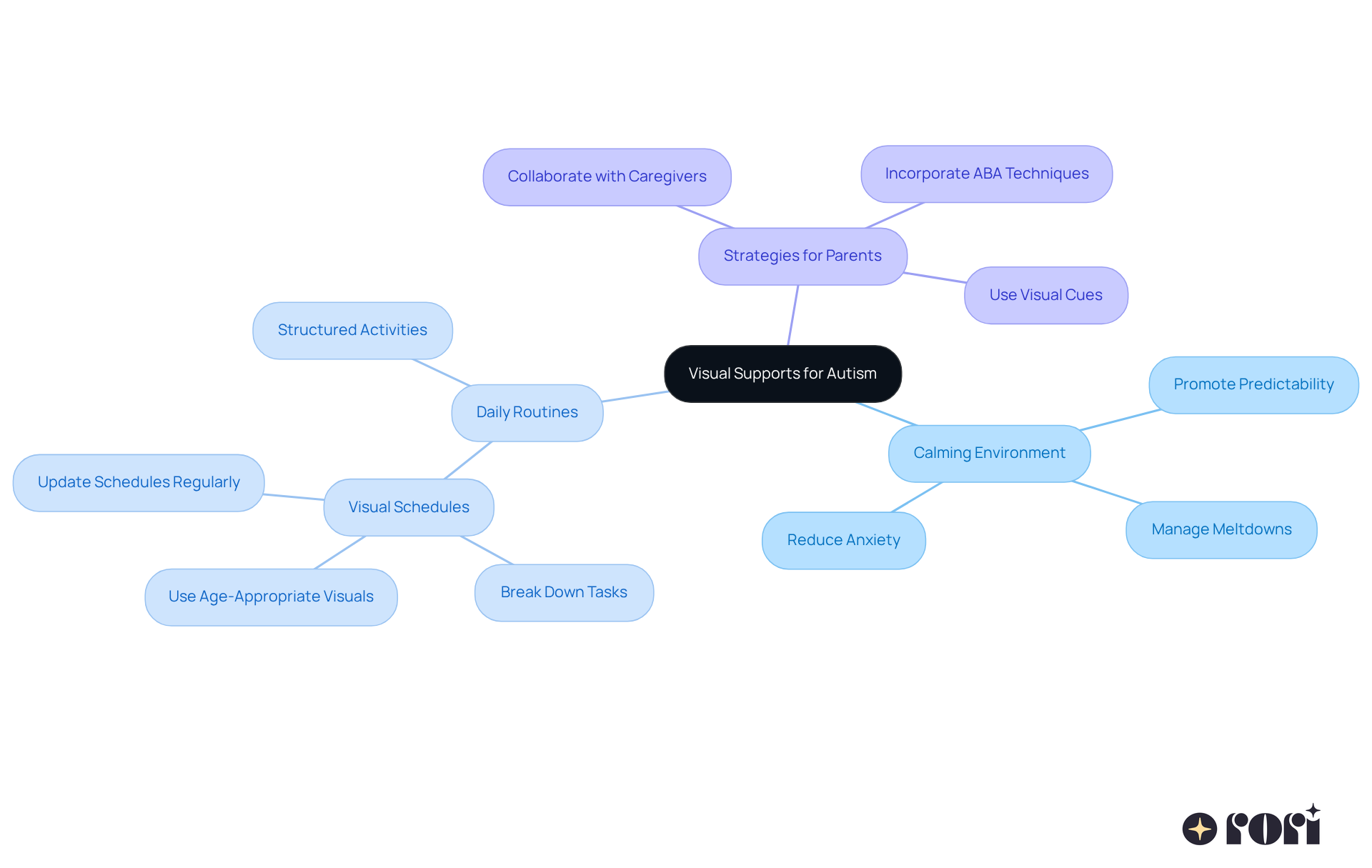This article dives into seven essential calming tools for autism that every parent should know. These tools play a crucial role in helping children on the spectrum manage their emotions and sensory experiences. It’s all about finding personalized strategies that work for your child, like weighted blankets, noise-canceling headphones, and mindfulness techniques. These can really make a difference in creating a calming environment tailored to their unique needs.
As parents, we often face challenges in supporting our children’s emotional regulation. It can feel overwhelming at times, right? But you’re not alone! Many parents have found that incorporating calming tools into their routines has led to significant improvements. For instance, a weighted blanket can provide that comforting hug your child needs during stressful moments.
Let’s explore this together! Mindfulness techniques, too, can be a game-changer. Simple practices like deep breathing or guided imagery can help your child feel more grounded. And don’t forget about noise-canceling headphones! They can be a lifesaver in busy environments, allowing your child to focus and feel safe.
It’s important to remember that every child is different. What works for one might not work for another, and that’s perfectly okay! The key is to experiment and find what resonates with your child. By doing so, you’re not just enhancing therapeutic outcomes; you’re also creating a nurturing space where they can thrive.
So, let’s take this journey together! Share your experiences or thoughts in the comments below. We’re here to help you every step of the way!
Understanding the unique challenges faced by children with autism is so important for creating supportive environments that truly foster emotional well-being. In this article, we’ll dive into seven essential calming tools that can empower parents and caregivers to enhance their child's emotional regulation and overall growth.
But how can we tailor these strategies to meet individual needs? What specific tools can really make a difference in daily life? Exploring these questions opens up a treasure trove of resources and techniques designed to transform the experience of managing autism into a more positive and manageable journey.
Let’s explore this together!
At Rori Care, we truly believe in the power of personalized calming tools for autism within ABA therapy. It’s all about equipping caregivers with the right knowledge about ABA principles, so they can make informed choices that positively impact their child’s emotional regulation and overall growth. By conducting thorough assessments, clinicians can pinpoint specific triggers and preferences unique to each child, ensuring that the calming tools we use really resonate with their individual needs.
Imagine using weighted blankets for deep pressure or sensory toys that align with a young person’s interests. These strategies not only work effectively but also act as calming tools for autism, creating a comforting environment during therapy sessions. And let’s not forget soothing visuals, such as gentle LED lights and visual timers, which serve as excellent calming tools for autism in managing feelings. Did you know that up to 90% of individuals with autism experience some form of sensory processing disorder? That’s why these tailored strategies, which include calming tools for autism, are so essential—they significantly enhance therapeutic outcomes and make the whole experience more enjoyable.
Interestingly, 78% of families with autism feel that how they tackle challenges is even more important than the challenges themselves. This really highlights the value of customized strategies in managing emotions and empowering caregivers to support their kids effectively. Plus, we always set measurable goals to track progress, ensuring that the strategies we implement are truly effective in achieving the desired outcomes.
Let’s explore this together! We’re here to help you every step of the way!

Calming tools for autism are essential in assisting young individuals to manage sensory overload. For instance, weighted blankets can be a game-changer! They provide comforting pressure that soothes anxiety and promotes relaxation. Experts highlight how these blankets foster a sense of security, which is so important for emotional well-being.
Another fantastic resource is noise-canceling headphones. These little wonders significantly reduce overwhelming sounds, allowing sensitive ears to find some peace. They help kids separate from chaotic environments, giving them a chance to regain their composure.
And let’s not forget about fidget toys! Stress balls and spinners can be great distractions, keeping little hands busy and redirecting focus away from overwhelming sensations. Together, calming tools for autism not only provide instant calming but also help develop long-term sensory regulation skills. This way, young individuals can navigate their surroundings with greater ease.
Exciting new sensory products are popping up all the time, offering parents a variety of options tailored to their child’s unique needs. It’s all about ensuring they have the best resources available to tackle sensory challenges. Let’s explore this together! We’re here to help you every step of the way!

Deep breathing techniques can serve as calming tools for autism, significantly helping to reduce anxiety in kids, especially those on the autism spectrum. Two fun methods that really shine are 'bubble exercises' and 'rainbow techniques.' With bubble exhalation, children can imagine blowing bubbles as they breathe out. This not only helps them relax but also sparks their creativity, turning the whole experience into a joyful activity. Who wouldn’t love a little playtime that lifts their spirits?
Now, let’s talk about rainbow visualization. This technique involves picturing the colors of a rainbow while inhaling and exhaling. Research shows that just one to two minutes of rainbow breathing can significantly lower stress levels and boost focus. It’s like a little mental reset during tough times! Plus, studies indicate that using calming tools for autism can help kids manage their emotions better, making them more aware of when they need a break.
Parents can introduce these techniques during calm moments and reinforce them when stress kicks in. For instance, kids can practice rainbow inhalation to calm their energy and give themselves a much-needed 'brain break.' This approach not only equips them with reliable coping strategies but also incorporates calming tools for autism to empower them to handle their feelings effectively. By weaving bubble and rainbow techniques into daily life, families can create a nurturing environment that supports mental well-being and resilience.
As Michael Vallejo, LCSW, puts it, "Rainbow inhalation merges deep respiration and visualizing the hues of the rainbow to assist kids in relaxing." And don’t forget, rainbow breathing printables can be a handy tool for parents to help their kids visualize and practice these techniques. Let’s explore this together and see how these simple practices can make a big difference!

Creating a calm-down space as one of the calming tools for autism can be a game-changer for children, but it takes some thought to get it just right. Imagine soft, adjustable lighting and soothing colors like gentle blues and muted greens. These shades can really help set a relaxing mood, making the space feel welcoming and comfortable. Cozy seating options, like bean bags or ergonomic chairs, can turn this area into a little retreat where kids can unwind.
Incorporating calming tools for autism such as:
can really enhance the vibe. As Carmen Sinata beautifully puts it, "When my space feels chaotic, my mind does too. But when I take a few small steps to make my environment more peaceful, I instantly feel lighter, more focused, and more myself." Visual aids, such as calming posters or picture schedules, serve as calming tools for autism that can help kids know what to expect in their safe haven, which is crucial for their self-regulation.
Encouraging kids to personalize this space with their favorite books, stuffed animals, or sensory objects not only makes it more appealing but also helps them take charge of their own relaxation. A thoughtfully designed calm-down area that incorporates calming tools for autism can truly be a sanctuary, promoting emotional stability and self-regulation. By weaving these elements together, parents can create a supportive environment that invites their little ones to relax and manage their emotions effectively. Let’s explore this together!

Movement-based strategies serve as effective calming tools for autism, helping young individuals feel calm and centered. Think about activities like yoga, dancing, or even some good old stretching exercises. These fun movements allow kids to shake off that pent-up energy and ease their anxiety. Establishing a routine that includes these physical activities can really empower children to manage their emotions better.
Outdoor play is another fantastic way for kids to release energy and boost their overall well-being. Research shows that regular physical activity can significantly reduce anxiety and behavioral outbursts, highlighting its value as one of the essential calming tools for autism care. Plus, yoga—described by Amit Ray as a 'science of well-being'—is all about combining body, mind, and soul. It encourages mindfulness and body awareness, which can help kids regulate their feelings more effectively.
By weaving in movement-based strategies like:
into daily life, parents can create a nurturing environment that supports their children's emotional health. And let’s not forget about the importance of a soothing atmosphere! Gentle lighting and other calming tools for autism can really help young ones manage their emotions better.
So, let’s explore this together! By embracing these strategies, we can make a positive impact on our kids' lives. We’re here to help you every step of the way!

Visual supports such as schedules, charts, and social stories are effective calming tools for autism that can help create a calm environment for our kids. By setting up visual schedules that clearly outline daily routines, parents can help their little ones know what’s coming next. This way, we can reduce anxiety and the chances of those meltdowns we all dread.
You know, studies show that kids with autism often feel more in control when they know what to expect. It’s amazing how a little predictability can lead to a calmer atmosphere at home! Plus, visual cues do wonders in communicating expectations, making it easier for kids to understand and follow along. This organized approach not only eases stress but also involves calming tools for autism that help our children manage their daily lives with more confidence and independence.
To get started with visual supports, parents can:
Keeping those visual schedules updated is key to keeping our young learners engaged and adapting to their changing needs. Working together with caregivers and experts to create these schedules ensures consistency across different settings, which is so beneficial for our kids’ development.
And let’s not forget about equipping caregivers with ABA principles and strategies! This really boosts their ability to support their children’s behavioral goals, leading to better outcomes and a happier family dynamic. Let’s explore this together and see how we can make a positive impact!

Mindfulness techniques, including guided imagery, meditation, and sensory awareness exercises, can be effective calming tools for autism to help kids manage their feelings. Research shows that these methods can really help reduce anxiety and boost overall well-being. For instance, mindfulness-based approaches have shown promise in improving emotional regulation and decreasing aggressive behaviors among young people with autism. In fact, 11 out of 14 studies looking at social skills reported positive changes! Plus, Conner et al. found that parents noted a significant drop in anxiety, which really highlights how effective these techniques can be.
As a parent, you can introduce simple mindfulness techniques to support your child in managing emotions. One great method is the '5-4-3-2-1' grounding exercise. In this practice, kids identify:
This not only helps them become more aware of their emotions and surroundings but also fosters a sense of calm and control.
Guided imagery and meditation can be considered effective calming tools for autism that play a big role in emotional regulation. These techniques encourage kids to visualize peaceful situations, which can help them handle intense emotions and sensory overload. Mindfulness practices like deep breathing exercises and body scans have been shown to improve self-awareness, allowing kids to recognize and manage their feelings more effectively. However, it’s worth noting that the overall quality of the studies reviewed is considered low, so it’s important to be cautious about making strong recommendations based on these findings.
By weaving these mindfulness strategies into your daily routines, you can create a nurturing environment that promotes emotional well-being and resilience in your children. Let’s explore this together and see how these techniques can make a difference!

Personalized calming tools are so important for helping children with autism navigate their emotional landscapes. By weaving tailored strategies into daily routines, parents and caregivers can create an environment that meets each child's unique needs, boosting their emotional regulation and overall well-being.
Throughout this article, we've highlighted various calming tools, like sensory products such as weighted blankets and noise-canceling headphones. We’ve also explored deep breathing techniques, including bubble and rainbow exercises, and the creation of calm-down spaces that promote relaxation. Plus, movement-based strategies and mindfulness practices have shown to be effective in easing anxiety and building emotional resilience. These insights really emphasize the value of a well-rounded approach that combines different tools and techniques to help children with autism manage their emotions.
Ultimately, when parents are equipped with knowledge and resources to implement these calming strategies, it can lead to wonderful improvements in their children's emotional health. By exploring and adopting these essential calming tools, families can foster a nurturing atmosphere that not only helps children cope with sensory overload but also encourages them to thrive in their everyday lives. Let’s continue this journey of discovery and support together, ensuring that every child has access to the calming strategies they need to succeed!
What is Rori Care's approach to ABA therapy for autism?
Rori Care focuses on personalized calming tools within ABA therapy, equipping caregivers with knowledge about ABA principles to support their child's emotional regulation and growth.
How does Rori Care determine the appropriate calming strategies for each child?
Clinicians conduct thorough assessments to identify specific triggers and preferences unique to each child, ensuring that the calming tools resonate with their individual needs.
What are some examples of calming tools used in ABA therapy?
Examples include weighted blankets for deep pressure, sensory toys aligned with a child's interests, soothing visuals like gentle LED lights, and visual timers.
Why are tailored calming strategies important for individuals with autism?
Tailored strategies enhance therapeutic outcomes and create a more enjoyable experience, especially since up to 90% of individuals with autism experience some form of sensory processing disorder.
What percentage of families with autism prioritize how they tackle challenges?
78% of families with autism believe that their approach to challenges is more important than the challenges themselves.
How does Rori Care track the effectiveness of their strategies?
Rori Care sets measurable goals to track progress, ensuring that the strategies implemented are effective in achieving desired outcomes.
What are some essential sensory tools for calming sensory overload?
Essential sensory tools include weighted blankets, noise-canceling headphones, and fidget toys like stress balls and spinners.
How do weighted blankets benefit individuals with autism?
Weighted blankets provide comforting pressure that soothes anxiety, promotes relaxation, and fosters a sense of security, which is crucial for emotional well-being.
What role do noise-canceling headphones play in managing sensory overload?
Noise-canceling headphones significantly reduce overwhelming sounds, helping sensitive individuals regain composure in chaotic environments.
How do fidget toys assist children with sensory challenges?
Fidget toys, such as stress balls and spinners, serve as distractions that keep little hands busy and redirect focus away from overwhelming sensations, aiding in sensory regulation.